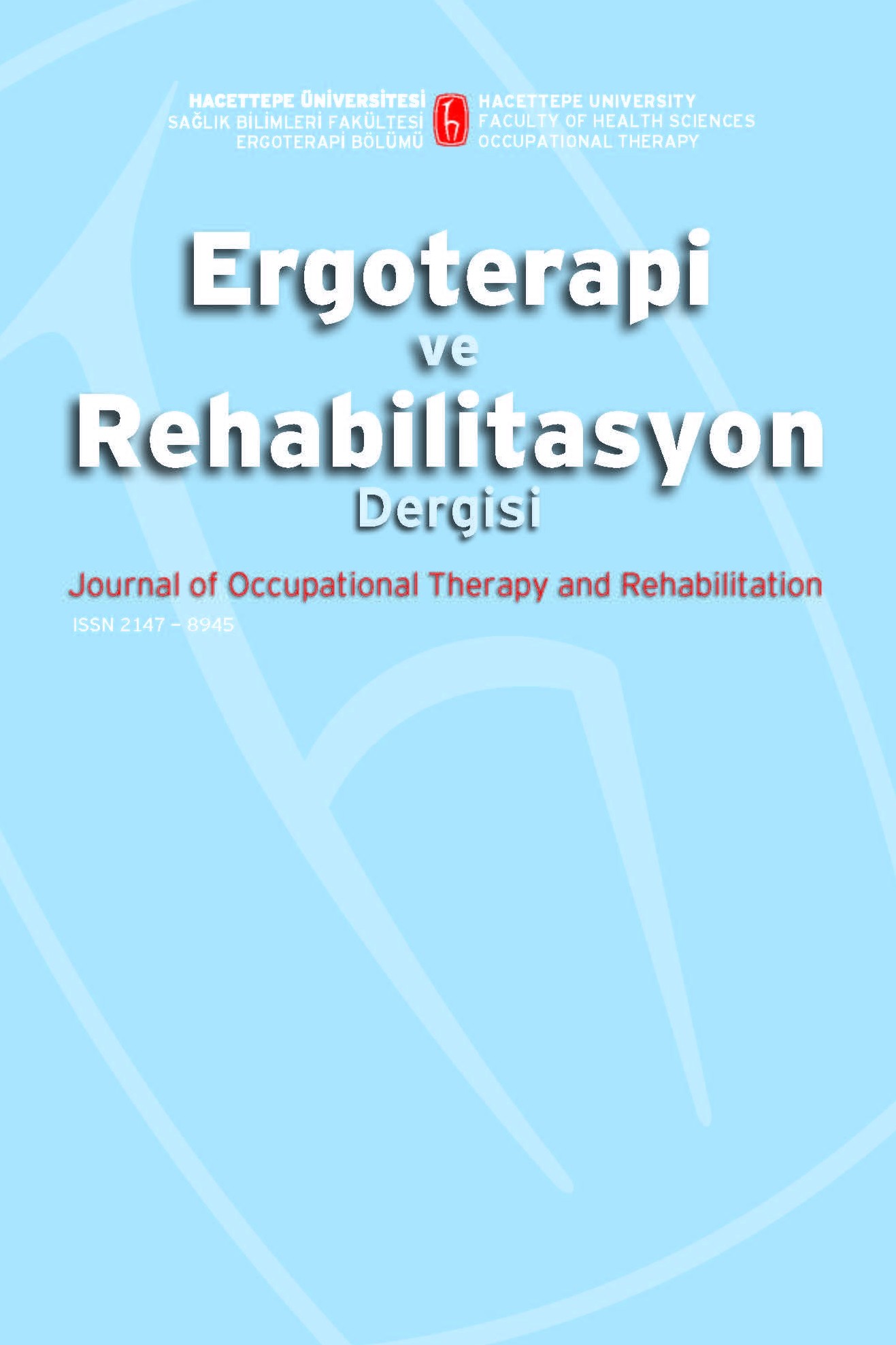Çalışan Üst Ekstremite Problemli Özürlülerin Aktivite Düzeyi, Serbest Zaman ve Toplumsal Katılım Düzeylerinin İncelenmesi
Amaç: Çalışmanın amacı endüstri ortamında çalışan ve üst ekstremite defisitine sahip bedensel engellilerin toplumsal katılım düzeylerinin incelenmesi idi. Gereç ve yöntem: Katılımcıların demografik bilgilerinin yanında çalıştıkları sektörler kaydedildi. Toplumsal katılım düzeyini değerlendirmek için Yeti Yitimi Değerlendirme Çizelgesi–II (WHO-DAS-II), aktivite performansını değerlendirmek için Kanada Aktivite Performans Ölçümü (KAPÖ), boş zaman tatmin düzeyini incelemek için ise Serbest Zaman Tatmin Ölçeği (SZTÖ) kullanıldı. Sonuçlar: Çalışmaya yaş ortalamaları 35,50±9,23 yıl olan 18’i (%26,9) kadın, 49’u (%73,1) erkek 67 bedensel engelli alındı. Çalışmaya dahil edilen hastaların 13’ü (%19,4) hemiparatik serebral paralizi tanısına sahipti, 12’sinde (%17,9) üst ekstremite amputasyonu mevcuttu. Katılımcıların WHO-DAS-II toplam puanının otalaması 19,49±1,20, KAPÖ toplam puan ortalaması 8,46±2,60, SZTÖ toplam tatmin puanı ortalaması ise 3,59±0,49 olarak bulundu. KAPÖ’nün tüm alt ölçekleriyle WHO-DAS-II’nin toplam puanı arasında istatistiksel olarak negatif yönde anlamlı bir ilişki bulundu (p<0,05). SZTÖ toplam tatmin puanıyla WHO-DAS-II’nin toplam puanı arasında istatistiksel olarak negatif yönde anlamlı bir ilişki bulundu (p<0,05). Tartışma: Çalışmada aktivite performansı ve serbest zaman tatmininin toplumsal katılım düzeyini etkilediği tespit edildi. Üst ekstremite defisitine sahip olan bedensel engellilerde fizyoterapi ve iş ve uğraşı tedavisi programları yanında sanatsal, kültürel ve sportif etkinliklerin arttırılması, bu aktivitelerin teşvik edici olması toplumsal katılımın artırılması açısından gereklidir
Anahtar Kelimeler:
Toplumsal Katılım, Üst Ekstremite, Bedensel Engelli, Engelli Çalışan
The Investigation of Activity Level, Leisure and Community Participation in Disabled Workers with Upper Extremity Problem
Purpose: The aim of this study was to analyse the community participation level of disabled individuals with upper extremity deficit, who work in the industry. Material and Methods: The participants were asked about their demographical status and which sectors they work in. Disability Assessment Schedule–II (WHO-DAS-II) was used to evaluate the community participation level; Canadian Occupational Performance Measure (COPM) was utilized to evaluate the activity performances; Recreational Time Satisfaction Schedule (RTSS) was used to evaluate their level of satisfaction for recreational time. Results: 67 disabled individuals, 18 (%26,9) of them being female; 49 (%73,1) of them being male, with an average age of 35,50±9,23 were included in the study. Analysing the diagnosis of the disabled individuals with upper extremity deficit who we included in the study; we saw that 13 (19,4%) of them had hemiparathic cerebral paralysis; 12 (17,9 %) of them had upper extremity amputation. The mean total score of WHO-DAS-II was 19,49±1,20; the mean score of COPM was 8,46±2,60 and the mean score of RTSS satisfaction was 3,59±0,49. A significant and statistically negative relationship between the all COPM results and total WHO-DAS-II score was found (p<0,05). It was found a significant negative relationship between total RTSS satisfaction score and total WHO-DAS-II score (p<0,05). conclusion: In this study, it was found that activity performance and recreational time satisfaction affect the community participation. Therefore, beside the physiotherapy and occupational therapy programs; it is necessary to enhance and increase artistic, cultural and sport activities for disabled individuals with upper extremity deficit in order to increase the community participation
- ISSN: 2147-8945
- Yayın Aralığı: 3
- Başlangıç: 2013
- Yayıncı: Hacettepe Üniversitesi Sağlık Bilimleri Fakültesi
